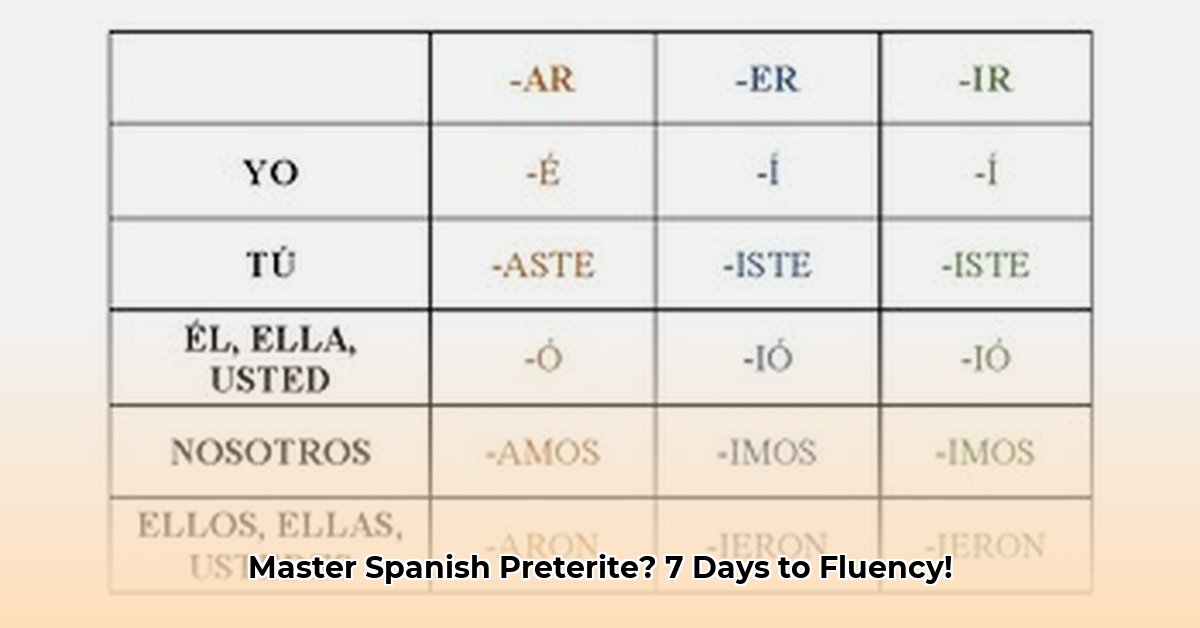
Understanding the Spanish Preterite Tense: Your Gateway to Fluent Conversation
The preterite tense in Spanish is your key to describing completed actions in the past. Think of it as the equivalent of the simple past tense in English ("I walked," "she sang," "they ate"). Mastering the preterite is crucial for narrating stories, recounting experiences, and engaging in natural-sounding conversations. Don't be intimidated; this guide will break down the process into manageable steps, making mastering this essential tense achievable. Did you know that consistent, focused practice for just 15 minutes a day significantly boosts retention? For further preterite practice, check out this helpful resource.
Regular Verb Conjugation: The Building Blocks of Fluency
Most Spanish verbs are regular, meaning their conjugations follow predictable patterns. This section will equip you with the tools to conjugate these verbs with ease. First, identify the infinitive (the base form of the verb, ending in -ar, -er, or -ir). Then, simply remove the infinitive ending and add the appropriate preterite ending from the chart below:
| Pronoun | -ar Verbs (e.g., hablar - to speak) | -er Verbs (e.g., comer - to eat) | -ir Verbs (e.g., vivir - to live) |
|---|---|---|---|
| yo (I) | -é | -í | -í |
| tú (you) | -aste | -iste | -iste |
| él/ella/usted (he/she/you formal) | -ó | -ió | -ió |
| nosotros/nosotras (we) | -amos | -imos | -imos |
| vosotros/vosotras (you all - Spain) | -asteis | -isteis | -isteis |
| ellos/ellas/ustedes (they/you all - formal) | -aron | -ieron | -ieron |
Let's conjugate hablar (to speak): hablé, hablaste, habló, hablamos, hablasteis, hablaron. See? It’s straightforward once you understand the pattern.
Irregular Verb Conjugation: Mastering the Exceptions
While many verbs follow regular patterns, some don't. These are called irregular verbs. However, don't let this discourage you! Many irregular verbs share similarities, making memorization more manageable. Let's focus on three frequently used irregular verbs:
- Ser (to be): fui, fuiste, fue, fuimos, fuisteis, fueron.
- Ir (to go): fui, fuiste, fue, fuimos, fuisteis, fueron. (Note: The same as ser!)
- Hacer (to do/make): hice, hiciste, hizo, hicimos, hicisteis, hicieron.
Focus on memorizing these key verbs. Use flashcards (physical or digital) for effective retention. Remember, even irregular verbs exhibit patterns once you familiarize yourself with them.
Practice Exercises: Putting Your Knowledge into Action
The key to mastering any language is consistent practice. Here's an exercise to test your understanding:
Translate the following sentences into Spanish using the preterite tense:
- I played soccer.
- She went to the beach.
- We studied Spanish.
- You (singular, informal) ate pizza.
- They watched a movie.
Check your answers using a trusted online resource like SpanishDict 1.
Your 7-Day Master Plan: A Structured Approach to Preterite Proficiency
This plan provides a structured approach to mastering preterite conjugation within a week. Remember, consistency is key: short, focused sessions are more effective than infrequent, lengthy ones.
Day 1-2: Focus solely on regular -ar verbs. Practice conjugating at least 10 different -ar verbs.
Day 3-4: Move on to regular -er and -ir verbs. Conjugate at least 15 new verbs. Mix and match -ar, -er, and -ir verbs within sentences to solidify your understanding.
Day 5: Tackle irregular verbs ser, ir, and hacer. Focus on memorizing their conjugations and using them in various sentences.
Day 6: Review all verb types, practicing writing complex sentences that incorporate both regular and irregular verbs. Create short narratives using the preterite tense.
Day 7: Test your knowledge! Write a short paragraph or story detailing a past event using only the preterite tense.
Key Takeaways: Your Path to Preterite Mastery
- Mastering the Spanish preterite is essential for fluency.
- Regular verbs follow predictable conjugation patterns.
- Irregular verbs require memorization, but patterns exist within the irregularities.
- Consistent practice, utilizing multiple learning methods (flashcards, spaced repetition, writing exercises) is crucial.
- Embrace mistakes as learning opportunities—they are your stepping stones to success.
Remember, success in language learning is a cumulative process. Celebrate your progress, stay motivated, and enjoy the journey! ¡Buena suerte! (Good luck!)